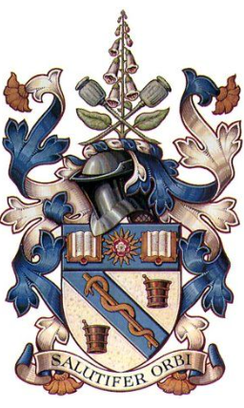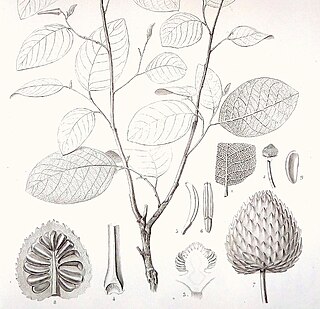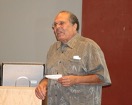Related Research Articles

Herbal medicine is the study of pharmacognosy and the use of medicinal plants, which are a basis of traditional medicine. With worldwide research into pharmacology, some herbal medicines have been translated into modern remedies, such as the anti-malarial group of drugs called artemisinin isolated from Artemisia annua, a herb that was known in Chinese medicine to treat fever. There is limited scientific evidence for the safety and efficacy of many plants used in 21st-century herbalism, which generally does not provide standards for purity or dosage. The scope of herbal medicine sometimes include fungal and bee products, as well as minerals, shells and certain animal parts.

The UCL School of Pharmacy is the pharmacy school of University College London (UCL). The School forms part of UCL's Faculty of Life Sciences and is located in London, United Kingdom.

Pharmacognosy is the study of crude drugs obtained from medicinal plants, animals, fungi, and other natural sources. The American Society of Pharmacognosy defines pharmacognosy as "the study of the physical, chemical, biochemical, and biological properties of drugs, drug substances, or potential drugs or drug substances of natural origin as well as the search for new drugs from natural sources".

Medicinal plants, also called medicinal herbs, have been discovered and used in traditional medicine practices since prehistoric times. Plants synthesize hundreds of chemical compounds for various functions, including defense and protection against insects, fungi, diseases, and herbivorous mammals.

Medicinal or pharmaceutical chemistry is a scientific discipline at the intersection of chemistry and pharmacy involved with designing and developing pharmaceutical drugs. Medicinal chemistry involves the identification, synthesis and development of new chemical entities suitable for therapeutic use. It also includes the study of existing drugs, their biological properties, and their quantitative structure-activity relationships (QSAR).

Annona squamosa is a small, well-branched tree or shrub from the family Annonaceae that bears edible fruits called sugar apples or sweetsops. It tolerates a tropical lowland climate better than its relatives Annona reticulata and Annona cherimola helping make it the most widely cultivated of these species. Annona squamosa is a small, semi-(or late) deciduous, much-branched shrub or small tree 3 to 8 metres tall similar to soursop. It is a native of tropical climate in the Americas and West Indies, and Spanish traders aboard the Manila galleons docking in the Philippines brought it to Asia.
The American Society of Pharmacognosy (ASP) is a scientific society that promotes the growth and development of pharmacognosy through presentation of research achievements and publication of meritorious research.

Asimina triloba, the American papaw, pawpaw, paw paw, or paw-paw, among many regional names, is a small deciduous tree native to the eastern United States and southern Ontario, Canada, producing a large, yellowish-green to brown fruit. Asimina is the only temperate genus in the tropical and subtropical flowering plant family Annonaceae, and Asimina triloba has the most northern range of all. Well-known tropical fruits of different genera in family Annonaceae include the custard-apple, cherimoya, sweetsop, ylang-ylang, and soursop.

Acetogenins are a class of polyketide natural products found in plants of the family Annonaceae. They are characterized by linear 32- or 34-carbon chains containing oxygenated functional groups including hydroxyls, ketones, epoxides, tetrahydrofurans and tetrahydropyrans. They are often terminated with a lactone or butenolide. Over 400 members of this family of compounds have been isolated from 51 different species of plants. Many acetogenins are characterized by neurotoxicity.
Varro Eugene Tyler, of Auburn, Nebraska, was an American professor of pharmacognosy and philatelist who specialized in the study of forged postage stamps and the forgers who created them.
Willem Frans Daems, PhD was a pharmacist, anthroposophist, pianist, teacher and editor.
John Wilkinson is an English independent scientist specialising primarily in organic chemistry, phytochemistry, pharmacognosy, and synergism in botanical medicines, botanical foods and ecological biochemistry, and who led the first European degree course for herbal medicine, at Middlesex University in the United Kingdom in 1994.
Niebla josecuervoi is a fruticose lichen that grows on rock, stony soil and sand along the Pacific Coast of northern Baja California from near Misión San Vicente Ferrer to Punta Santa Rosalilillita. The epithet, josecuervoi is in honor of a field assistant, “Jose Cuervo”.
Norman Robert Farnsworth was a pharmacognosist, professor, and author.
Peggoty Mutai is a Kenyan chemist. Born in Kericho, her interests include medicinal chemistry, in particular working with the search for new treatments against parasitic worms.
Mark S. Cushman is an American chemist, whose primary research is in the area of medicinal chemistry. He completed his pre-pharmacy studies at Fresno State College (now California State University, Fresno) in 1965. He then attended the University of California San Francisco (as a University of California Regents Scholar), earning a Pharm.D. in 1969 and a Ph.D. in Medicinal Chemistry in 1973. Thereafter, he performed postdoctoral training in the laboratory of George Büchi, Ph.D., at the Massachusetts Institute of Technology (MIT). There, his research focused on the discovery and development of new synthetic methodologies, and the isolation and structural characterization of mycotoxins from Aspergillus niger. In 1975, he joined the Department of Medicinal Chemistry and Molecular Pharmacology (at the time, Department of Medicinal Chemistry and Pharmacognosy) at Purdue University. From 1983 to 1984, Prof. Cushman was a Senior Fulbright Scholar at Munich Technical University working in the laboratory of Professor Adelbert Bacher. His sabbatical work dealt with the design and synthesis of probes to elucidate key aspects of the biosynthesis of riboflavin (vitamin B2). Currently he holds the rank of Distinguished Professor Emeritus of Medicinal Chemistry at Purdue University. He has mentored 40 graduate students, 59 postdoctoral researchers, and 5 visiting scholars. He has published 348 papers and holds 41 patents. His work has ~17,000 citations with an h-index of 69. His most cited papers had 471, 403, and 299 citations as of August 2021. He has made seminal contributions to the fields of synthetic and medicinal chemistry including the development of new synthetic methodologies, the synthesis of natural products, and the preparation of antivirals, antibacterials, and anticancer agents, and mechanism probes to understand the function of over thirty macromolecular targets. One of his main scientific contributions is the development of the indenoisoquinolines, molecules that inhibit the action of toposiomerase I (Top1) and stabilize the G-quadruplex in the Myc promoter. Three indenoisoquinolines designed and synthesized by his research group at Purdue University [indotecan (LMP 400), indimitecan (LMP 776), and LMP 744] demonstrated potent anticancer activity in vivo and have completed phase I clinical trials at the National Institutes of Health.

Annona bullata is a species of plant in the family Annonaceae. It is native to Cuba. Achille Richard, the French botanist who first formally described the species, named it after the bubbled appearance of the spaces between the fine network of veins in the leaves.

Phillip Crews is an African American chemist at UCSC. His research work is around marine natural products chemistry and diversity education in chemistry. He was elected a Fellow of the American Association for the Advancement of Science in 2008.
George Robert Pettit II was a Regents’ Professor in Chemistry in the School of Molecular Sciences (SMS) at Arizona State University. He was an internationally renowned and respected researcher in the field of natural anticancer compounds throughout his career of over six decades. Pettit has been honored by the International Cancer Advocacy Network, the American Society of Pharmacognosy, and Washington State University, his alma mater. A special edition of the Journal of Natural Products is dedicated to Pettit, and the French journal Médicine Sciences paid tribute to him. Pettit’s achievements earned him the designation of Outstanding Investigator by the United States National Institutes of Health National Cancer Institute (NCI). Pettit and his impact on the field of anti-cancer compounds are the subject of the book, “Waging War on Cancer.”
Djaja D. Soejarto is an Indonesian-born botanist, ethnobotanist, pharmacognosist, academic and author. He is an adjunct curator at the Field Museum of Natural History as well as professor emeritus in the Department of Pharmaceutical Sciences and at the Pharmacognosy Institute of the College of Pharmacy, the University of Illinois at Chicago.
References
- ↑ "Department of Medicinal Chemistry and Molecular Pharmacology directory - Jerry L. McLaughlin". Mcmp.purdue.edu. Retrieved 2012-05-07.
- ↑ McCage, CM; Ward, SM; Paling, CA; Fisher, DA; Flynn, PJ; McLaughlin, JL (2002). "Development of a paw paw herbal shampoo for the removal of head lice". Phytomedicine. 9 (8): 743–8. doi:10.1078/094471102321621377. PMID 12587697.
- ↑ McLaughlin, Jerry L. (2008). "Paw Paw and Cancer: Annonaceous Acetogenins from Discovery to Commercial Products". Journal of Natural Products. 71 (7): 1311–21. doi:10.1021/np800191t. PMID 18598079.
- ↑ Archived August 19, 2009, at the Wayback Machine
- ↑ "Grants and Awards Archive « The American Society of Pharmacognosy". Pharmacognosy.us. Retrieved 2012-05-07.